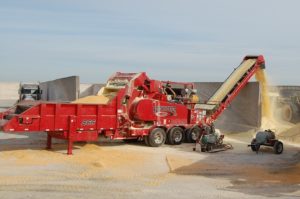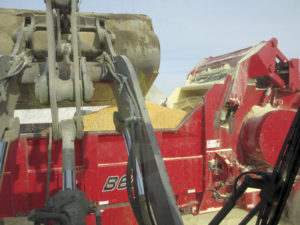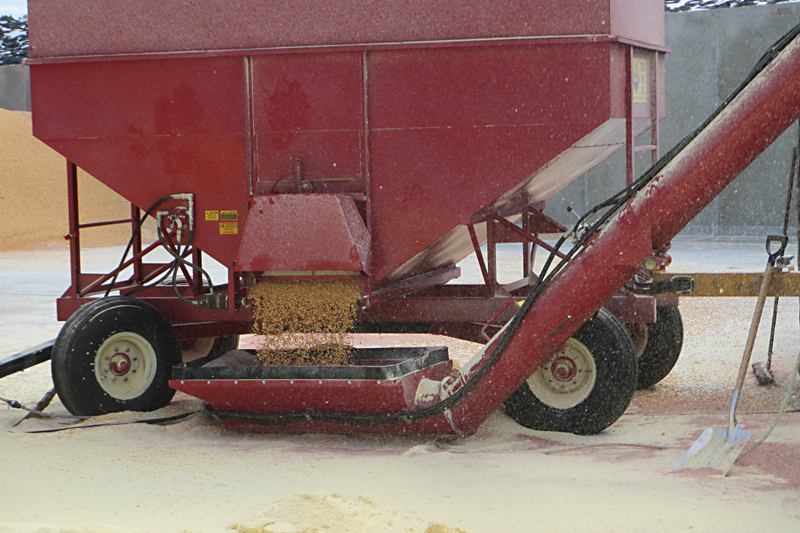The next year, however, he found himself hauling the 765 horsepower industrial grinder onto a large dairy operation in Kansas to grind baled corn stover. A few months later, he was grinding high moisture shell corn for a large dairy in Wisconsin. Although he had no intentions of grinding agricultural materials when he bought the B-66, he was pleasantly surprised when he saw the economics of agricultural grinding. He was even more surprised to learn that the machine he bought for railroad ties actually had some significant advantages over other machines commonly used for grinding agricultural materials.
Noyes was not the only one to notice these advantages. Noyes was surprised to see the dairy operators so impressed after watching the B-66 in action for only a short time. Going into the project, Noyes assumed that virtually any agricultural or industrial grinder would handle high-moisture shell corn (HMSC). But as he learned, “Shell
corn is very easy to grind but difficult to grind properly.”
Demanding Size Specifications
On one hand, shell corn is one of the easiest materials to run through a grinder. The abrasion is minimal compared to other feedstocks like railroad ties, bark, asphalt shingles, yard waste, or corn stover. The likelihood of contaminants (rock and steel) is exceedingly small. Essentially, grinding shell corn is “about as far removed from grinding railroad ties as you can get,” Noyes notes.
On the other hand, HMSC has several unique challenges. The biggest challenge is achieving the right particle size. “The dairies want a product that looks like the corn meal you would buy in a grocery store,” Noyes states. Grinding corn to a fine texture optimizes its digestibility and hence its overall value as a feed source. As Noyes relates, oversized pieces are considered lost profitability. Thus, with a production rate of over 4,000 bushels per hour, the B-66 had to hit the size specification exactly. Even a small percentage of overs would quickly add up to a large amount of lower value feed.
“I only have this opportunity because I have a Rotochopper,” Noyes says. “The other high-volume grinders I have seen wouldn’t come close to making this fine of a particle size. Shell corn is already smaller going into the grinder than the particle size most industrial grinders can produce. You would have a lot of whole kernels in the product pile if you tried this with other horizontal grinders.”
Uniquely Suited for High-Moisture Fine Grinding

Another challenge is the high moisture content. In general, the higher the moisture level of a raw material, the lower the grinding efficiency. Traditional hammermills with swinging hammers—the type of machine normally associated with grinding corn—cannot process HMSC efficiently and may experience plugging. The high moisture content, however, poses no problems for the B-66.
The Rotochopper B-66 was certainly not the first machine put to the task of sizing high moisture shell corn. In fact, it wasn’t even the first Rotochopper grinder used to process high moisture shell corn. Before Noyes arrived with his 765 horsepower B-66, the dairy operation had already brought in a Rotochopper owner with a 540 horsepower MC-266 at a different location. Pleased with the end material and production rate of the MC-266, they decided to bring in another Rotochopper, since winter was rapidly approaching and they had tens of thousands of bushels to grind. With more horsepower and a larger screen surface than the MC-266, the B-66 had a higher production rate than the MC-266 but offered a virtually identical end product consistency.
“I only have this opportunity because I have a Rotochopper. The other high-volume grinders I have seen wouldn’t come close to making this fine of a particle size.”
Streamlined Grinding Simplicity

Although a Rotochopper grinder was not the first machine to successfully process HMSC at this dairy operation, it was the first to combine all the objectives into one machine. By bringing in a Rotochopper grinder, the dairy operators were able to achieve their goals for end product size, throughput capacity, and, most importantly, simplicity.
When Noyes started grinding HMSC, his B-66 was able to replace a complex assortment of equipment, which included three tub grinders, along with gravity bins, augers, and front end loaders to carefully meter HMSC into the tub grinders. The only support equipment Noyes needed was a front end loader with a bucket big enough to keep up with his B-66.
By dramatically simplifying the HMSC sizing process, the dairy managers were able to re-allocate man-hours during their busiest time of year. The dairy operators also took notice of the substantial reduction in maintenance downtime. When they had been using a complex system comprised of several machines, a breakdown of any machine could bring the whole process to an instant halt. The B-66, on the other hand, “performed flawlessly every minute the engine was running,” Noyes remarks. “Farms can’t afford downtime during the harvest season.”
Ready to Grind with Minimal Hassle

Before Noyes began the shell corn grind, the Rotochopper R & D team developed a unique screen for grinding shell corn to the consistency of coffee grounds. With only some minor modifications, the B-66 was ready to grind HMSC.
After Noyes started grinding agricultural materials, he began to appreciate a whole different set of features and advantages of the B-66. For grinding railroad ties, Noyes knew that uptime, grinding efficiency, and minimized maintenance costs are the primary factors that determine profitability. “When you’re grinding railroad ties, no matter how careful you are, eventually you’re going to hit a tie plate,” Noyes states. “But with the B-66, I am usually back up and running very quickly. I might have a broken rotor tooth or maybe even a broken tooth mount. At most I’ve had an hour or two of downtime after hitting a big piece of steel. I’ve seen tie plates take down other grinders for periods of extended downtime that might involve torching, welding, and waiting for parts.”
Unmatched Versatility
Accordingly, when he was grinding railroad ties, Noyes appreciated features like the replaceable mount rotor and screen change system, which helped limit downtime from tie plates. Now, Noyes has come to appreciate the versatility that allows the same machine to switch from railroad ties to HMSC with ease. In addition to processing bales and shell corn for dairy operations, Noyes’s custom grinding business has encompassed raw materials that are more commonly associated with horizontal grinders, such as pallets. Even with these more common materials, however, Noyes has appreciated the unique capabilities of his B-66 for achieving the required end product specs.
“From railroad ties to high moisture shell corn, the Rotochopper B66 can do it all,” Noyes states. “In the big picture, grinding high moisture shell corn is a few weeks out of the year (albeit the best weeks of the year for my grinding business). With the B-66’s versatility, I am ready for whatever comes my way.”










